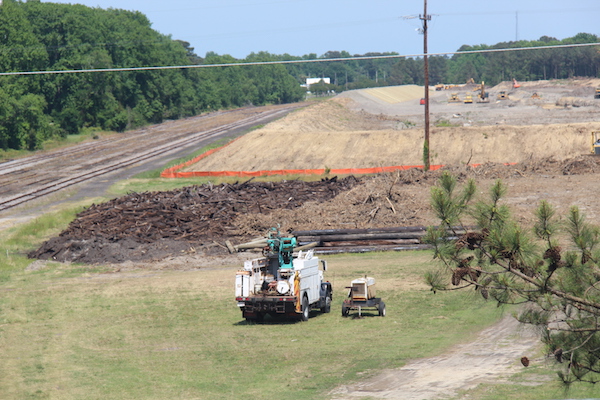Bay Coast Railroad Must Move Hazardous Railroad Ties

Pile of railroad ties in foreground were amassed by the Army Corps of Engineers while preparing the spoil containment area in the background. The photo was taken from the Hump. (Wave photo)
By DORIE SOUTHERN
Cape Charles Wave
June 29, 2015
Bay Coast Railroad has been given five days to come up with a plan to properly dispose of creosote-treated railroad ties currently being buried behind the Cape Charles Museum. After the Wave alerted the Virginia Department of Environmental Quality, DEQ sent a letter to Bay Coast Railroad, owners and operators of the Cape Charles rail yard, requesting a response within five days detailing what will be done to remove or recycle the material. That response is due today (June 29).
Creosote-treated products such as railroad ties must be disposed of in an approved landfill or be recycled appropriately. According to DEQ, the railroad ties must be treated as hazardous waste.
DEQ had not been aware of the large number of railroad ties amassed at the western end of the area being prepared to contain dredged spoil from the town harbor and channel. The mound of ties can easily be seen when driving over the Hump.
The regional DEQ representative, who asked not to be quoted by name, said the railroad was not allowed to use its property as an unpermitted dump site.
DEQ spokesman Bill Hayden told the Wave that he did not know whether the railroad ties could contaminate the water table.
CONTINUED FROM FIRST PAGE
The railroad ties appear to have been unnoticed in a prior location. When the Army Corps of Engineers began preparing the spoil site, the ties were moved to their current location. But DEQ promises they will not be allowed to stay there permanently.
Creosote-treated lumber is used for railroad ties, telephone poles, etc., but is no longer allowed to be sold for residential uses such as landscaping timbers. Creosote contains carcinogenic chemicals believed to be a health concern principally for workers who are in daily contact with the material.
The chemicals in creosote can leach out into the soil and the ground water. Concerns were raised with the DEQ about contamination of the soil and water table. But DEQ employees did not raised red flags about the creosote, noting that railroad ties are used on the ground.




















So our drinking water could have been contaminated by the railroad ties? Just another sneaky thing happening in our little town. Thanks Dorie for looking out for us all.
Northampton county and the town of Cape Charles should immediately pass an ordinance to require all railroads in their jurisdiction to use concrete railroad ties instead of creosote ties. These ties are stronger, last longer and could develop a secondary market for Bayshore Concrete resulting in increased employment for the shore.